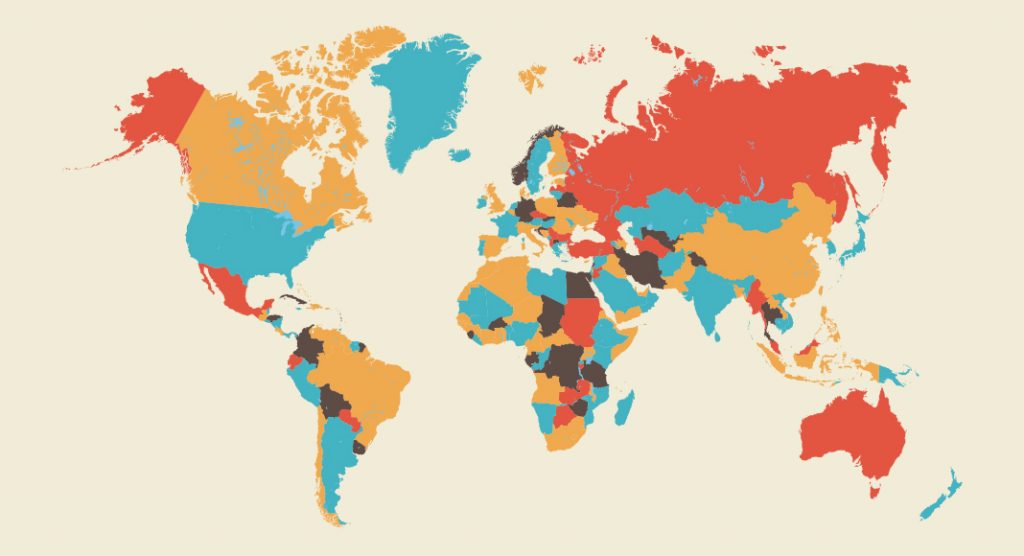Nielsen Data suggests that businesses are taking a specific approach to the spokespeople they choose when they’re aiming to appeal to bilingual audiences. Voices staff, clients and talent weigh in on their experiences walking the fine line between English and Español.
It was reported years ago that the U.S. has more Spanish speakers than Spain, but the growth in this key bilingual audience is far from over. Projections are showing that Spanish-English speakers in the U.S. will only continue to rise. This influx has resulted in a diverse mix, even among the bilingual population. For instance, many Millennials will have grown up speaking Spanish at home, and English in social situations, while other generations may have a strong preference to communicating solely in Spanish whenever possible.
In this article
- The Research
- Nielsen Takes a Look into the Minds of Bilingual Millennials
- Voices Staff Insights
- Voice Acting Trends Related to Spanish-English Bilingual Audiences
- Hiring Voice Actors for Global Bilingual Market

- Marketing to Bilingual Spanish-English Audiences on a Global Scale Must Be Flawless
- Language Choice Depends on Creative Team’s Vision
- Most Clients Opt for Native Speakers
- It’s Important to Use the Specific Spanish Accent and Dialect of the Target Audience
- Selecting Voice Actors for Bilingual Audiences in North America
- Non-Native Speakers Are Still Considered ‘Authentic’ if Fluent
- Actors Chosen by the Appeal of Their Voice – Not Native Language
- A Voice Actor’s Experience Completing Work for Bilingual North American Markets
- 1. Use an English Voice with a Slight Latin American Accent
- 2. Create Two Versions of the Same Ad, One in English, One in Neutral Spanish
- 3. Mix English and Spanish Together in the Same Recording
- A Producer’s Point of View on Hiring Voice Actors for Bilingual Projects
- Younger Hispanic Markets Are More Apt to be OK with Spanglish
- The General Bilingual Market Prefers Separate Ads
- Bilingual Preferences are Very Different from Coast to Coast
- A Bilingual Spanish-English Speaker on What Language She Connects with Most in Advertising
- In Summary
- Are You Looking for the Perfect Voice to Connect with Your Unique Audience?
As a result of this complexity, many companies are scratching their heads as to how to reach the bilingual demographic.
Advertising is a psychological and highly emotional play, after all, and language is woven tightly into both how we think and feel. Businesses want to know if they should choose to disseminate their ads in English, Spanish, or both – in order to have the most impact.
We take a look at the statistics and research – and weigh it against the experience of Voices staff, clients, and voice talent – all of whom are actively working towards solving this puzzle, each and every day.
The Research
Nielsen Takes a Look into the Minds of Bilingual Millennials
Leave it to one of the world’s most renowned research companies to tackle this issue ‘head-on.’ Nielsen took a look at the bilingual brain so that advertisers might have better insights upon which to hedge their commercial bets.
Specifically, they asked:
- Does the emerging population of bilingual Millennials respond differently to messaging when it is in Spanish than when it is in English?
- What are the best ways to reach and connect with Hispanic bilingual Millennials?
- How does the language of television programming influence how the advertisement is received by the consumer?
Their findings were definitely interesting, and in a nutshell, suggested that:
“Spanish-language advertising did a better job connecting with Bi-Llennials in a range of scenarios, particularly when the ads’ content was emotional in nature. Ads featuring social interaction were generally more emotionally engaging and memorable for Bi-Llennials in Spanish than in English. Similarly, branding sequences were more effective in Spanish than in English.” Nielsen, The Bilingual Brain
Voices Staff Insights
Voice Acting Trends Related to Spanish-English Bilingual Audiences

Naturally, the Nielsen results are of interest to anyone looking to hire a voice actor who can speak to this unique audience.
And for Voices Strategic Development Managers, Sergio Cordoba and Trevon Buccione, these insights are particularly interesting, as each help clients from Latin America (LATAM) and the United States, (respectively), who are attempting to make a Spanish-English audience connection.
Here they share their perspectives on both the global trends and how commercial production in the U.S. differs.
Hiring Voice Actors for Global Bilingual Market
Marketing to Bilingual Spanish-English Audiences on a Global Scale Must Be Flawless
“My focus is on Global Latin American markets, and so, naturally, 80 per cent of the projects I manage require Spanish voice over, and almost all of the projects are intended for Latin American audiences,” says Sergio Cordoba, Strategic Development Manager, Global Markets, at Voices.
“The Nielsen study is incredibly interesting, with some key points for marketers to consider. Specifically, here are some insights I can share from my years of working with business clients and the major brands they serve:”
Language Choice Depends on Creative Team’s Vision
The order of production (i.e. Spanish to English or vice-versa) depends 100% on the creative team that was responsible for a specific campaign idea. For example, a major brand has a main creative theme developed at their principal agency or record, and then their global network within multiple markets are responsible for working around that main theme to create pieces that can either be used only locally (e.g. only in LATAM) or that can be ‘picked up’ for global distribution. So, here is where we see the piece being localized from either language to the other.
Most Clients Opt for Native Speakers
“If and when an adaptation occurs (e.g. a commercial is adapted later to English or Spanish), it is imperative that the voice over actors are 100% native. And on that note, it can be hard for some clients to find talent that can speak two languages, 100% accent-free.
At Voices, we do have voice over actors who have that ability. However, in the majority of the cases, clients feel that if you choose a bilingual talent you might be compromising one of the two languages, which could have a negative impact on your audience.”
It’s Important to Use the Specific Spanish Accent and Dialect of the Target Audience
Furthermore, in Spanish, there are so, so many accents and particularities between country dialects that clients need to be sensitive to the specific markets they are targeting. As an example, when we assist clients with adaptation/localization projects for a regional campaign in LATAM, we often ensure to record multiple versions of the piece with native talent from each country where the piece will be airing.
Sometimes there are small script changes to reflect country-specific terminology, but most important is the authenticity of the accent. So imagine how incredibly compromising it could be if a brand uses a bilingual talent whose English is better than their Spanish!
Selecting Voice Actors for Bilingual Audiences in North America

Cordoba’s insights are complemented by Voices Business Development Manager, Trevon Buccione, whose clients are concentrated in the Western U.S. According to Buccione, while U.S. advertisers value authenticity, that doesn’t necessarily mean ‘accent free.’
Here are his insights:
Non-Native Speakers Are Still Considered ‘Authentic’ if Fluent
When a client requests a bilingual talent (Spanish) for a project they emphasize authenticity. In my experience, clients often prefer the talent to be of Spanish heritage with the capabilities of speaking fluent English as opposed to vice-versa.
Actors Chosen by the Appeal of Their Voice – Not Native Language
I have a client who requests that each spot be recorded by a native Spanish speaker and another actor who is a native English speaker, however, this preference is more closely tied to how those particular actors’ voices appeal to them.
The selection of fluently bilingual Spanish-English voice actors is not as broad as the native speakers, meaning the client has more choice among the latter group.
A Voice Actor’s Experience Completing Work for Bilingual North American Markets
Daniela Sierra is a Colombian five-star rated voice actor on Voices, who has been using her voice for the past 12 years in various audio applications – from commercials to movies, TV spots as well as jingles, and commercials. She also works as a voice over coach for those looking to start a career in Latin American voice over.
“In my experience with projects oriented to bilingual audiences in the United States I have come across three different types of clients and requirements,” she says.
Here are the three vocal directions she most commonly receives:
1. Use an English Voice with a Slight Latin American Accent
The first type of customer is clear on wanting Spanish-speaking markets to identify with their products, but they do not want to stop promoting them in English. That’s why they look for voices that speak English with excellent fluency and pronunciation, but that are not native.
They seek to have “a slight Latin American accent” (e.g. on many occasions I have been sent Sofia Vergara’s voice and accent as a reference) so that, even though this audience does not completely identify with the language, they can connect with the accent, which travels through the words, making the product or service feel closer.
This type of customer uses these voices mostly for advertising, TV spots, radio tags, and all mass-produced advertising material within the United States.
2. Create Two Versions of the Same Ad, One in English, One in Neutral Spanish
The second type of client prefers to have two versions, one in each language. They want the English version to be completely native and, for the Spanish adaptation, they want the voice to speak what we call ‘Latin American or neutral Spanish,’ which is a way of speaking the Spanish language that doesn’t correspond to a specific geographical place and has no local characteristics of any country. Instead, it seeks to reach all of them (21 countries, approximately 470 million people).
This kind of Spanish is generic and impartial in its vocabulary, pronunciation, and musicality.
These clients are those who export their content and work with film and TV dubbing, e-learning, business material, telephone systems, etc.
3. Mix English and Spanish Together in the Same Recording
I have rarely stumbled upon clients who want to combine Spanish and English in the same audio file, making the project bilingual. But I did have cases where the need was more specific and they needed to include some slang in English or very local terms. However, other than that, this is not a common request.
A Producer’s Point of View on Hiring Voice Actors for Bilingual Projects
“We have a couple of clients that really focus on a bilingual market,” says Harry Karidis, Founder and Producer at Harry Karidis Productions. Harry’s company is based in Los Angeles, CA, but completes projects for clients across the US, who mostly focused in the travel industry.
“We do everything from broadcast television spots to on-site and have done on-hold messaging on the phone when you call in, both English and Spanish. These clients really need to cater to both,” he says. “Typically, these clients are typically high-end hotels and casinos in Arizona or very close to the border, where they serve a general market as well as the Spanish market. For instance, a lot of the folks will come up from Mexico and make a weekend of staying at a beautiful resort. So they get a lot of traffic from both markets.”
Younger Hispanic Markets Are More Apt to be OK with Spanglish
The younger Hispanic market has grown up speaking both languages, which is sometimes referred to as Spanglish (when English and Spanish are mixed together at the same time). We’ve actually done a couple of spots where we’ll use both languages in the same spot.
The General Bilingual Market Prefers Separate Ads
The general market is still the most important segment that takes the lead for the work I do. When we are creating for them, we’ll produce our commercial material in English first and then we translate into Spanish. However, as any Spanish speaker will tell you, not everything translates perfectly, so most of the time we’ll book in an English-speaking talent for the general market and then a Spanish speaking one for the Spanish market.
Once in a while, we’ll look for a bilingual actor whose first language would be Spanish, maybe with a slight accent.
Bilingual Preferences are Very Different from Coast to Coast
I’ve done work in Florida as well, and the Spanish there is very different from in Arizona or Texas and so we always look to find a voice actor who understands that dialect.
A Bilingual Spanish-English Speaker on What Language She Connects with Most in Advertising
Although she is often the voice behind the advertisement, Daniela Sierra is also a bilingual Spanish-English speaker herself. Spanish is her first language, and it definitely still resonates with her – but it depends on the situation.
“In my opinion as a consumer and not as a voice talent, I prefer to always receive advertising content in Latin American Spanish, and if I’m being sold a product or service, I prefer when the brand speaks completely in my language, whether on TV, internet or radio,” she says.
“However, in terms of entertainment content like video games, film, and television, I usually choose the English language, and for that reason, it is very valuable that in this type of material, we have the option to choose in which language we want to use it.”
In Summary
It seems as though the Nielsen study, although reported on a few years ago, still rings true today, as the bilingual Spanish-English population in the US continues to grow.
Although the global bilingual market may still be closely tied to receiving messages in their native tongue, complete with the nuances of dialect and accent, in North America, audiences are slightly more relaxed.
However, for advertisers who are on the fence as to whether or not to use Spanish in their advertising, all sources (Voices account managers, voice talent, and clients) seem to agree that advertising in Español is always the best bet when you really want to win over new fans and customers.
Are You Looking for the Perfect Voice to Connect with Your Unique Audience?
Learn more about the diversity of professional voice over talent and translation services at Voices.


Leave a Reply